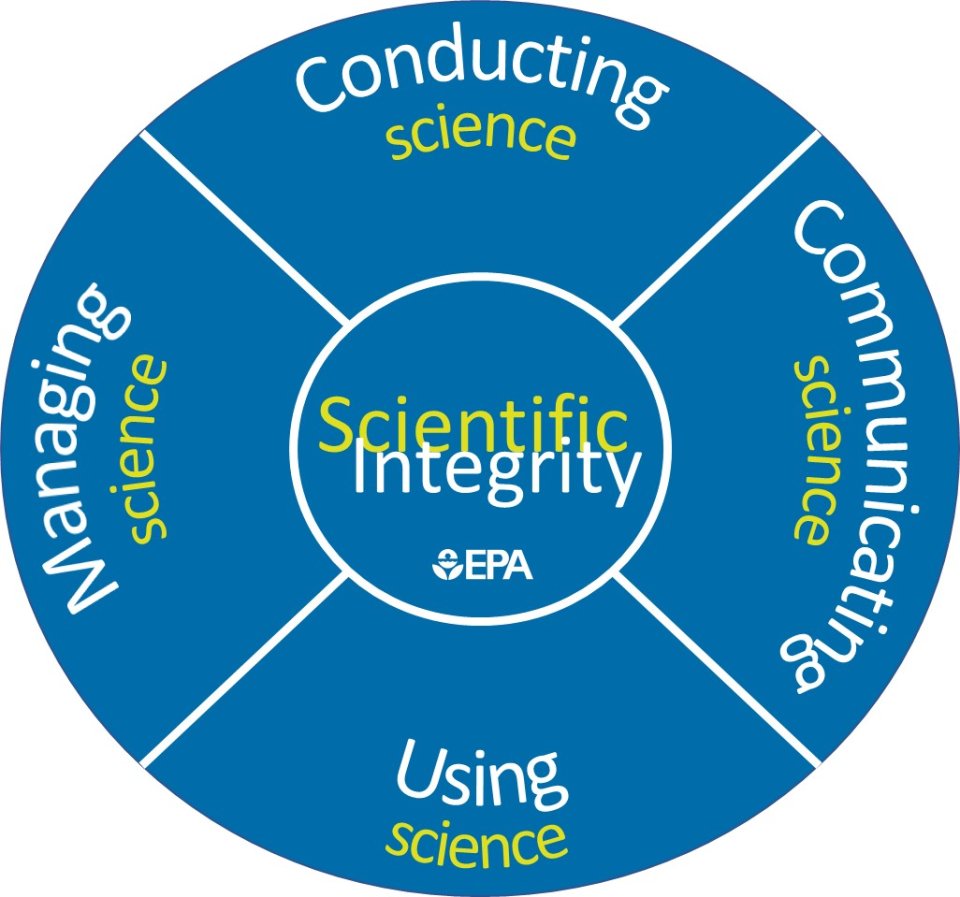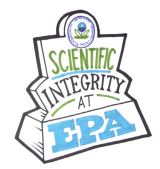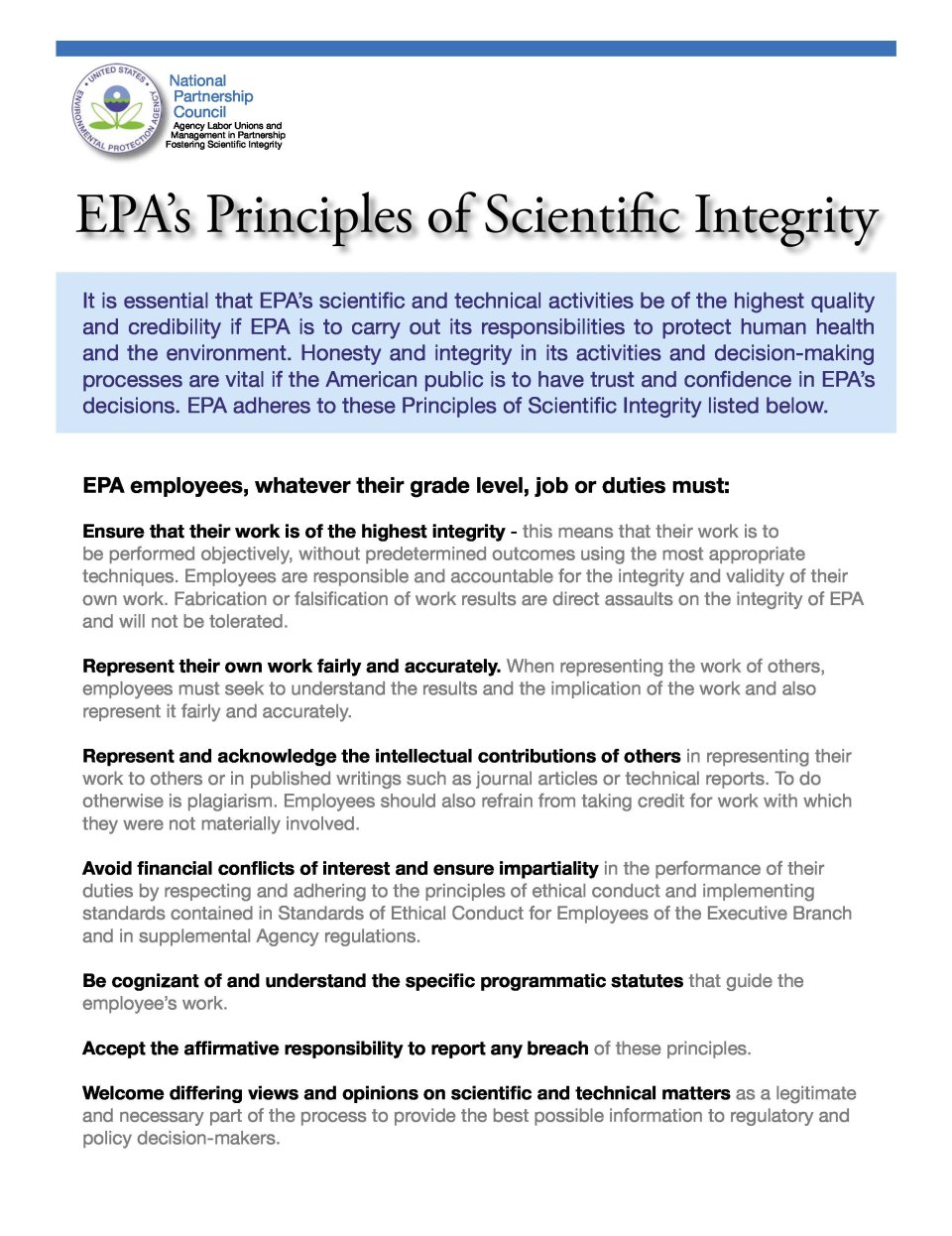Scientific Integrity at EPA
On This Page:
-

- What is Scientific Integrity?
- Why is Scientific Integrity Important?
- Introduction to Scientific Integrity at EPA Whiteboard Video
- History of the Development of EPA's Scientific Integrity Policy
Overview
Scientific integrity at EPA is the responsibility of every employee, contractor, grantee, volunteer and collaborator who conducts, utilizes, supervises, manages, communicates, or influences scientific activities Activities that involve the development and application of scientific methods and theories in a systematic manner, including, but not limited to data collection, inventorying, monitoring, statistical analysis, surveying, observations, experimentation, study, research, integration, economic analysis, forecasting, predictive analytics, inference, modeling, technology development, scientific assessment, and qualitative analysis. [EPA 2025 Scientific Integrity Policy]. The Scientific Integrity Policy exists against a complicated regulatory backdrop. For example, the Scientific Integrity Policy works in conjunction with policies and procedures for addressing research misconduct Fabrication, falsification, or plagiarism in proposing, performing, or reviewing research, or in reporting research results; or ordering, advising, or suggesting that subordinates engage in research misconduct. Research misconduct does not include honest error or differences of opinion. [EPA 2025 Scientific Integrity Policy], information quality, quality assurance The management of an integrated system of activities involving planning, implementation, documentation, assessment, reporting, and quality improvement to ensure that a process, item, or service is of the type and quality needed and expected by the organization. [EPA 2025 Scientific Integrity Policy], and peer review A documented process for enhancing a scientific or technical work product so that the decision or position taken by the agency, based on that product, has a sound, credible basis. It is performed by credible individuals who are independent of those who performed the work and who are at least collectively equivalent in technical expertise to those who performed the original work. [EPA 2025 Scientific Integrity Policy]. The Policy also works in conjunction with statutes such as the Freedom of Information Act and Federal Advisory Committee Act.
What is Scientific Integrity?
Scientific integrity results from adherence to professional practices Conducting oneself with the qualities that are characterized by skill, competence, ethics, and courtesy. Professional practices may vary by scientific discipline and sub-discipline. [EPA 2025 Scientific Integrity Policy] and values, when conducting and applying the results of science The careful study of the structure and behavior of the physical world, especially by watching, doing experiments, and developing theories to describe the results. “Science” and “scientific” are expansive terms that refer to the full spectrum of scientific endeavors, e.g., basic science, applied science, engineering, technology, economics, social sciences (including program evaluation), and statistics, as well as the scientific and technological information derived from these endeavors. [EPA 2025 Scientific Integrity Policy] and scholarship. It ensures:
- Objectivity
- Clarity
- Reproducibility
- Utility
Scientific integrity is important because it provides insulation from:
Bias The systematic or persistent distortion of a measurement process which causes errors in one direction (i.e., the expected sample measurement is different from the sample's true value).
- Bias
- Fabrication Making up data or results and recording or reporting them. [EPA 2025 Scientific Integrity Policy]
- Falsification Manipulating research materials, equipment, or processes, or changing or omitting data or results such that the research is not accurately represented in the research record. [EPA 2025 Scientific Integrity Policy]
- Falsification The rejection of a hypothesis by demonstrating that it does not hold in a case. Falsificationists argue that hypotheses can be rejected but not accepted.Plagiarism The appropriation of another person’s ideas, processes, results, or words without giving appropriate credit and without appropriate permissions. [EPA 2025 Scientific Integrity Policy]
- Outside interference Inappropriate, scientifically unjustified intervention in the conduct, management, communication, or use of science. It includes, but is not limited to censorship, suppression, or distortion of scientific or technological findings, data, information, or conclusions; inhibiting scientific independence during clearance and review; scientifically unjustified intervention in research and data collection; and/or inappropriate engagement or participation in the peer review process or on federal advisory committees. Interference in this Policy does not refer to non-scientific parts of policy decisions or changes in agency priorities. [EPA 2025 Scientific Integrity Policy]
- Censorship
- Inadequate procedural and information security
Why is Scientific Integrity Important?
- Scientific integrity helps to build public support. People are more likely to support the Agency if they can trust the quality and integrity of its work.
- Scientific integrity, along with federal policies on research misconduct, conflicts of interest, and transparency help to ensure that EPA employees, contractors, and grantees can be held accountable to the public.
- Since EPA research often involves a great deal of cooperation and coordination among many different people in different disciplines and institutions, scientific integrity promotes the values that are essential to collaborative work, such as trust, accountability, and fairness. For example, data sharing policies, and confidentiality rules in peer review are designed to protect intellectual property interests while encouraging collaboration.
- Scientific integrity promotes the aims of research, such as knowledge, truth, and avoidance of error. For example, prohibitions against fabricating, falsifying, or misrepresenting research data promote the truth and avoid error.
Finally, scientific integrity promotes a variety of other important moral and social values, such as compliance with the law, and health and safety.

Introduction to Scientific Integrity at EPA Whiteboard Video
EPA’s scientific integrity program’s whiteboard training video “Introduction to Scientific Integrity at EPA” is an overview of scientific integrity, including EPA’s scientific integrity policy, how to report a scientific integrity concern, what constitutes a violation of the scientific integrity policy and important contact information and resources.
Introduction to Scientific Integrity at EPA
History of the Development of EPA’s Scientific Integrity Policy
While EPA's Scientific Integrity Policy dates from 2012, EPA has a long history of attention to scientific integrity. Many EPA administrators have addressed integrity and transparency in memos to the Agency. Administrator William Ruckelshaus drafted a memo in 1983 establishing a culture of integrity, which was followed in 1989 with one by Administrator William Reilly and another in 1993 by Administrator Carol Browner.
In 1999, the Agency published its Principles of Scientific Integrity, developed in conjunction with the EPA's National Partnership Council, which was comprised of representatives of Agency labor unions and management.

In March 2009, an Executive Memorandum directed the White House Office of Science and Technology Policy (OSTP) to develop a plan aimed at ensuring the integrity of federal science. The memo expressed the need for robust science to inform and guide decisions by Executive Branch departments and agencies. In response, Administrator Lisa Jackson issued a memorandum in May 2009 to all EPA employees that declared "Science must be the compass guiding our environmental protection decisions.…While the laws that EPA implements leave room for policy judgments, the scientific findings on which these judgments are based should be arrived at independently using well-established scientific methods, including peer review, to assure rigor, accuracy, and impartiality."
In December 2010, the White House Office of Science and Technology Policy (OSTP) provided guidance for the development of scientific integrity policies by federal agencies. The guidelines require agencies and departments to create or improve policies related to:
- Foundations of scientific integrity in government
- Public communications
- Use of federal advisory committees
- Professional development of scientists and engineers
Acknowledging differences in structure and degree of regulatory responsibility, agencies and departments were given some latitude in developing their policies.
In response to OSTP, EPA convened an ad hoc scientific integrity working group, with members from across the Agency. A few months later, EPA released its draft policy for public comment. All of the public comments were considered and, in combination with discussions with other Federal agencies, contributed to an improved final policy, which was released in February 2012. Shortly after this, EPA Deputy Administrator Bob Perciasepe issued a memo to all EPA employees announcing EPA’s scientific integrity policy and affirming the Agency’s commitment to scientific integrity.
EPA's Scientific Integrity Policy builds upon EPA's significant earlier scientific integrity efforts, focusing on the:
- Promotion of a culture of scientific integrity throughout the EPA
- Release of scientific information to the public
- Consistent use of peer review and federal advisory committees
- Professional development of government scientists
The Scientific Integrity Policy also established a Scientific Integrity Committee to provide oversight for its implementation. The committee, led by the Scientific Integrity Official, encourages consistent Policy implementation and further bolsters the EPA's broader efforts to ensure the integrity of the Agency's scientific, engineering, and other technical work.
